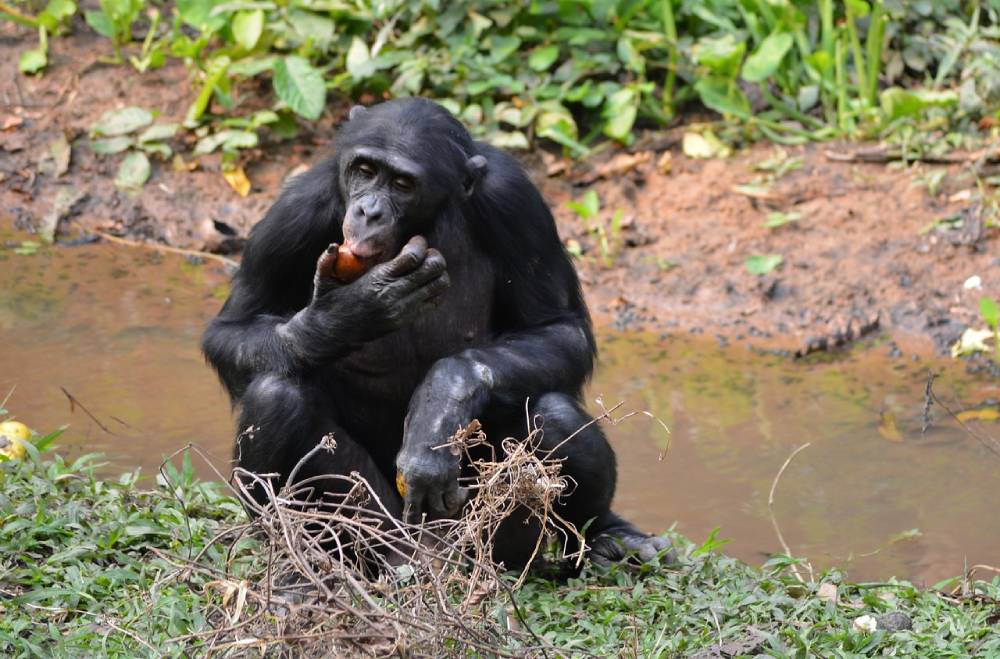Original Article: https://blog.theanimalrescuesite.greatergood.com/bonobo-facts/
February 14 is Valentine’s Day, but it’s also World Bonobo Day. It’s probably appropriate, as these apes – closely related to humans – are known for being lovers, not fighters. Learn more about this endangered species as you get ready to woo that special someone.
They Were Once Believed to be Another Chimpanzee

Bonobos have been referred to as pygmy chimpanzees because scientists once thought they were a small version of chimpanzees. They were first classified separately in 1933. There are plenty of differences between the two, though. Bonobos are smaller, have different diets, and are less aggressive than their chimpanzee cousins.
They’re Only Found in a Small Area

Bonobos have a fairly small range within the Democratic Republic of Congo. They’re found in the central basin of the country between two river systems: the Congo-Zaire-Walaba River and the Kwa-Kasai-Sankuru River. IUCN estimates their historic range at around 220,000 square miles.
They’re Our Closest Animal Relative

Bonobos and chimpanzees share more than 98% of their DNA with humans, making them our closest animal relatives. We split off from a common ancestor between 6 and 8 million years ago. Much like us, bonobos live in family groups, have a high level of intelligence, and often communicate with each other through hand and limb gestures.
Humans are pretty good at picking up those bonobo gestures, too. A recent study found that people were able to understand most of them, which researchers say shows we may have maintained some of our shared language from millions of years ago.
They’re a Matriarchal Society

When it comes to bonobos, females rule the roost, making them the only matriarchal great ape species. Offspring remain close by their mothers for several years, but daughters ultimately become independent, while sons remain within their mother’s group. Subgroups of the species generally revolve around an “alpha” female, her male offspring, and female associations.
Another interesting thing about the female relationships found among bonobos is that females have been observed helping mothers in labor. They provide protection and support, and have even been seen mimicking holding a baby to encourage the mother as she’s pushing.
Strangers Are Just Friends They Haven’t Met Yet

If there were an animal apt to chat you up on the bus in the morning, it may be the bonobo. They’re known to be xenophilic, which means they love strangers. They gladly share food with strangers, both in the wild and in captivity, and they’ve also been observed helping strangers get food that’s out of their reach. Even further, they will forgo food altogether to interact with a stranger.
To further prove their connection with those they don’t know, in one study, bonobos began spontaneous yawning when seeing videos of other unfamiliar bonobos yawning.
They’re More Peaceful Than Chimpanzees and Humans

Humans and chimpanzees have both been known to kill one of their own species, with chimps even partaking in cannibalism and infanticide. This has not been observed among bonobos, however.
In bonobo life, relationships between separate groups are not generally hostile, and females work to discourage aggressive behaviors in males. In fact, rather than making war, they make love. They often resolve conflicts with hugging, kissing, and sex.
They Communicate in Many Different Ways

Much like humans, bonobos can get their point across verbally and visually. The verbal communication can include whooping calls, screams, and grunts. They’ll even utter a food call when there’s some tasty grub nearby. They also tell each other a lot through facial expressions, like the silent baring of teeth, a silent pout, and a play face. Sometimes the two are combined, when a bonobo will couple a play face with a jerky breathing that sounds like laughter. This will happen during a tickle session or when group members are having fun.
Hand and foot gestures are often used by the species, as well.
They’re All About That Fruit

Bonobos get most of their food from plants, with fruit taking up the biggest share. They’ll also snack on leaves, roots, stems, flowers, and seeds. This plant-based portion of their diet plays a big role in seed dispersal in the Congo River Basin.
They’re more like flexitarians, though, because they will eat worms, insects, small fish, and small mammals when the opportunity presents itself. This isn’t typically as a result of hunting, though. It’s only when they happen to come across them.
They’re Very Playful

In addition to their more loving nature, bonobos have a lot of fun! Playing is an important part of childhood that helps the young grow and learn, and their chasing games can resemble what you might see kids doing on a playground. Research has also shown that these behaviors don’t go away as they age. Adults are also known to play amongst each other.
They’re Endangered

Bonobos are classified as endangered on the IUCN Red List. It isn’t known how many are left in the wild due to difficulties getting an accurate count. This is because of their remote range, research disruptions caused by the Congo War, and other factors. IUCN says minimum population estimates range from 15,000 to 20,000.
Threats include illegal hunting, the Congo War’s societal impacts and how they’ve put pressure on natural resources and wildlife, habitat degradation, agriculture, and deforestation.
Would you like to do your part to help endangered species also facing threats to their survival? Click here to learn how!
Source: The Animal Rescue Site Blog












